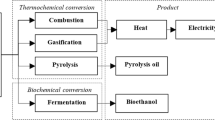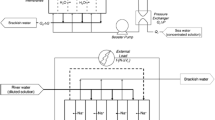Some scientists now proudly claim that the food problem is on the verge of being completely solved by the imminent conversion on an industrial scale of mineral oil into food protein—an inept thought in the view of what we know about the entropic problem. The logic of this problem justifies instead the prediction that, under the pressure of necessity, man will ultimately turn to the contrary conversion, of vegetable products into gasoline (if he will still have any use for it).
Nicholas Georgescu-Roegen (1973)
Abstract
While various energy-producing technologies have been analyzed to assess the amount of energy returned per unit of energy invested, this type of comprehensive and comparative approach has rarely been applied to other potentially limiting inputs such as water, land, and time. We assess the connection between water and energy production and conduct a comparative analysis for estimating the energy return on water invested (EROWI) for several renewable and non-renewable energy technologies using various Life Cycle Analyses. Our results suggest that the most water-efficient, fossil-based technologies have an EROWI one to two orders of magnitude greater than the most water-efficient biomass technologies, implying that the development of biomass energy technologies in scale sufficient to be a significant source of energy may produce or exacerbate water shortages around the globe and be limited by the availability of fresh water.



Similar content being viewed by others
References
Alcamo, J., et al. 2005. Changes in nature’s balance sheet: Model based estimates of future worldwide ecosystem services. Ecology and Society 10(2): 19.
Berndes, G. 2002. Bioenergy and water—the implications of large-scale bioenergy production for water use and supply. Global Environmental Change 12: 253–271.
Berndes, G. 2008. Bioenergy—a new large user of scarce water? In Food and water, ed. J. Förare. Formas: Forskningsrådet för miljö, areella näringar och samhällsbyggande.
Berndes, G., C. Azar, T. Kaberger, and D. Abrahamson. 2001. The feasibility of large-scale lignocellulose-based bioenergy production. Biomass & Bioenergy 20: 371–383.
Börjesson, P. 2008. Good or bad ethanol—what determines this? Report no. 65, Environmental and Energy Systems Studies, Department of Technology and Society, Lund University, Sweden.
Cleveland, C.J. 1992. Energy surplus and energy quality in the extraction of fossil fuels in the US. Ecological Economics 6: 139–162.
Cleveland, C.J. 2005. Net energy from oil and gas extraction in the United States. Energy 30: 769–782.
Cleveland, C.J., R. Costanza, C. Hall, and R. Kaufmann. 1984. Energy and the US economy: A biophysical perspective. Science 225: 890–897.
Drought threatens crop catastrophe. The Guardian, Apr 20, 2007. www.guardian.co.uk/australia/story/0,,2061761,00.html.
Farrell, A., R. J. Plevin, B. T. Turner, A. D. Jones, M. O’Hare, and D. M. Kammen. 2006. Ethanol can contribute to energy and environmental goals. Science 311: 506–508.
Flynn, H., and T. Bradford. 2006. Polysilicon: Supply, demand, and implications for the PV industry. Cambridge: The Prometheus Institute for Sustainable Development.
Georgescu-Roegen, N. 1973. The entropy law and the economic problem. In Toward a steady state economy, ed. H.E. Daly. San Francisco: W. H. Freeman and Company.
Giampietro, M., S. Ulgiati, and D. Pimental. 1997. Feasibility of large-scale biofuel production. BioScience 47: 587–600.
Gleick, P.H. 2000. The world’s water. Washington, DC: Island Press.
Goldemberg, J. 2007. Ethanol for a sustainable energy future. Science 315: 808–810.
Hagens, N.J., R. Costanza, and K. Mulder. 2006. Energy returns on ethanol production. Science 312: 1746.
Hall, C.A., C. Cleveland, and R. Kaufmann. 1986. Energy and resource quality: The ecology of the economic process. New York: Wiley.
Hill, J., E. Nelson, D. Tilman, S. Polasky, and D. Tiffany. 2006. Environmental, economic, and energetic costs and benefits of biodiesel and ethanol biofuels. Proceedings of the National Academy of Science 103: 11206–11210.
Hutson, S.S., N. L. Barber, J. F. Kenny, K. S. Linsey, D. S. Lumia, and M. A. Maupin. 2004. Estimated use of water in the United States in 2000. US Geological Survey, Circular 1268.
Kannan, R., C. Tso, R. Osman, and H. Ho. 2004. LCA-LCCA of oil fired steam turbine power. Energy Conversion and Management 45: 3093–3107.
Kennedy, D. 2007. The biofuels conundrum. Science 316: 515.
Lynd, L., and M.Q. Wang. 2004. A product-nonspecific framework for evaluating the potential of biomass-based products to displace fossil fuels. Journal of Industrial Ecology 7: 17–32.
Mann, M.K., and P. Spath. 1997. Life cycle assessment of a biomass gasification combined-cycle system. NREL/TP-430-23076. Golden: National Renewable Energy Laboratory.
Mortimer, N.D., M.A. Elsayed, and R. Matthews. 2003. Carbon and energy balances for a range of biofuel options. Sheffield: Resources Research Unit, Sheffield Hallam University.
Mulder, K., and N. Hagens. 2008. Energy return on investment—towards a consistent framework. AMBIO 37(2): 74–79.
National Research Council. 2008. Water implications of biofuels production in the United States. Report prepared by the Committee on water implications of biofuels production in the United States, National Research Council, ISBN: 978-0-309-11361-8.
Odling-Smee, L. 2007. Biofuels bandwagon hits a rut. Nature 446: 483.
Odum, H.T. 1973. Energy, ecology, and economics. AMBIO 2: 220–227.
Oki, T., and S. Kanae. 2006. Global hydrological cycles and world water resources. Science 313: 1068–1072.
Pimentel, D., et al. 1997. Water resources, agriculture, the environment and society. BioScience 47: 97–106.
Ragauskas, A.J., C. K. Williams, B. H. Davison, G. Britovsek, J. Cairney, C. A. Eckert, W. J. Frederick, Jr., J. P. Hallett, et al. 2006. The path forward for biofuels and biomaterials. Science 311: 484–489.
Renault, D., and W. Wallender. 2006. Nutritional water productivity and diets. Agricultural Water Management 45: 275–296.
Rijsberman, F.R. 2006. Water scarcity: Fact or fiction. Agricultural Water Management 80: 5–22.
Sanderson, K. 2007. A field in ferment. Nature 444: 673–676.
Sheehan, J., V. Camobreco, J. Duffield, M. Graboski, and H. Shapouri. 1998. An overview of biodiesel and petroleum diesel life cycles. NREL/TP-580-24772. Golden: National Renewable Energy Laboratory.
Smil, V. 2006. 21st century energy: Some sobering thoughts. OECD Observer 258/59.
Soddy, F. 1933. Wealth, virtual wealth and debt; the solution of the economic paradox, 2nd ed. New York: E.P. Dutton.
Spreng, D.T. 1988. Net-energy analysis and the energy requirements of energy systems. New York: Praeger.
Tainter, J.A., T. Allen, and T. Hoekstra. 2006. Energy transformations and post-normal science. Energy 31: 44–58.
Tilman, D., P. Reich, and J.M.H. Knops. 2006a. Biodiversity and ecosystem stability in a decade-long grassland experiment. Nature 441: 629–632.
Tilman, D., J. Hill, and C. Lehman. 2006b. Carbon negative biofuels from low impact high diversity grassland biomass. Science 314: 1598–1600.
United States Department of Agriculture—National Agriculture Statistics Service. 2007. http://www.nass.usda.gov/index.asp.
Vorosmarty, C.J., P. Green, J. Salisbury, and R.B. Lammers. 2000. Global water resources: Vulnerability from climate change and population growth. Science 289: 284–288.
Webber, M., and C. King. 2008. The water intensity of the plugged-in automotive economy. Environmental Science & Technology 42(12): 4305–4311.
Additional Data References for Tables 2 and 3
Alberta Chamber of Resources. 2006. Calgary, Alberta, Canada.
De Oliveira, M.E.D., B.E. Vaughan, and E.J. Rykiel. 2005. Ethanol as fuel: Energy, carbon dioxide balances, and ecological footprint. BioScience 55: 593–602.
deBoer, I. 2003. Environmental impact assessment of conventional and organic milk production. Livestock Production Science 80: 69–77.
Griffiths, M., A. Taylor, and D. Woynillowicz. 2006. Troubled waters, troubling trends: Technology and policy options to reduce water use in oil and oil sands development in Alberta. Drayton Valley: The Pembina Institute.
International Standard Organization. 1997. Environmental management—life cycle assessment—principles and framework. Geneva: ISO.
Kidd, S. 2004. Nuclear: Is there any net energy addition? Nuclear Engineering International 49: 12–13.
No author. 2006. Deer Creek Energy Limited: Joslyn SAGD Project—phase 2 application for approval. Environmental Impact Assessment.
Pimentel, D., and T. Patzek. 2005. Ethanol production: Energy and economic issues related to U.S. and Brazilian sugarcane. Natural Resources Research 14: 65–76.
Rafaschieri, A., M. Rapaccini, and G. Manfrida. 1999. Life cycle assessment of electricity production from poplar energy crops compared with conventional fossil fuels. Energy Conversion and Management 40: 1477–1493.
Shapouri, H., J. Duffield, and M. Wang. 2003. The energy balance of corn ethanol revisited. Transactions of the ASAE 46: 959–968.
Smeets, E., M. Junginger, A. Faaij, A. Walter, and P. Dolzan. 2006. Sustainability of Brazilian bio-ethanol. NWS-E-2006-110. Utrecht: Copernicus University.
Stiegel, G.J., et al. 2006. Estimating freshwater needs to meet future thermoelectric generation requirements. Pittsburgh: DOE/NETL-2006/1235, National Energy Technology Laboratory.
Tyson, S.K., C.J. Riley, and K.K. Humphreys. 1993. Fuel cycle evaluations of biomass—ethanol and reformulated gasoline. NREL/TP-463-4950. Golden: National Renewable Energy Laboratory.
U.S. Department of Agriculture. 2005. Oilseed yearbook.
U.S. Department of Energy. http://www.eere.energy.gov/afdc/.
Acknowledgments
Kenneth Mulder was supported by a grant from the Andrew W. Mellon Foundation. Nate Hagens was supported by a grant funded by the Moore Foundation. Brendan Fisher was supported by a grant from the Leverhulme Trust.
Author information
Authors and Affiliations
Corresponding author
Rights and permissions
About this article
Cite this article
Mulder, K., Hagens, N. & Fisher, B. Burning Water: A Comparative Analysis of the Energy Return on Water Invested. AMBIO 39, 30–39 (2010). https://doi.org/10.1007/s13280-009-0003-x
Received:
Accepted:
Published:
Issue Date:
DOI: https://doi.org/10.1007/s13280-009-0003-x




